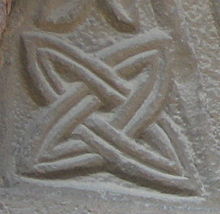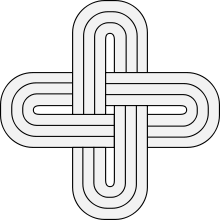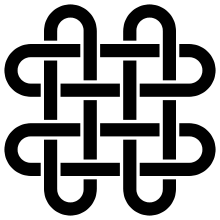- Solomon's knot
-
Not to be confused with Sigillum Solomonis, a name for the Polygonatum genus.
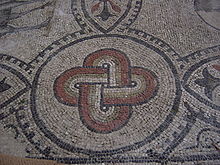 Ancient Roman mosaic in Aquileia (Italy)
Ancient Roman mosaic in Aquileia (Italy)
Solomon's knot (Latin sigillum Salomonis) is the most common name for a traditional decorative motif used since ancient times, and found in many cultures. Despite the name, it is actually classified as a link, and is not a true knot according to the definitions of mathematical knot theory.
Structure
The Solomon's knot consists of two closed loops, which are doubly interlinked in an alternating (interlaced) manner. In other words, if laid flat, the Solomon's knot is seen to have four crossings where the two loops interweave under and over each other (as opposed to only two crossings in the simpler Hopf link).
In most artistic representations, the parts of the loops that alternately cross over and under each other become the sides of a central square, while four loopings extend outward in four directions. The four extending loopings may have oval, square, or triangular endings, or may terminate with free-form shapes such as leaves, lobes, blades, wings etc.
Contents
Occurrences
The Solomon's knot often occurs in ancient Roman mosaics, usually represented as two interlaced ovals.
Tzippori National Park, Israel, has Solomon’s Knots in stone mosaics at the site of an ancient synagogue.
The Treasury, National Museum of Ireland, Archaeology, Dublin, Republic of Ireland displays the twelfth century CE Cross of Cong. In contrast to more elaborate designs usually seen are two very small Solomon’s Knots in simple, pure form at the junction of the Cross, one on either side of the Quartz Crystal covered hollow that once held a sliver of the Christian “True Cross.”
Across the Middle East, historical Islamic sites show Solomon's knot as part of Muslim tradition. It appears over the doorway of an early twentieth century CE mosque/madrasa in Cairo. Two versions of Solomon's knot are included in the recently excavated Yattir Mosaic in Jordan. To the east, it is woven into an antique Central Asian prayer rug. To the west, Solomon's knot appeared in Moorish Spain, and it shines in leaded glass windows in a late twentieth century CE mosque in the United States. The British Museum, London, England has a fourteenth century CE Egyptian Qur'an with a Solomon’s Knot as its frontispiece.
University of California at Los Angeles Fowler Museum of Cultural History, USA has a large African collection that includes nineteenth and twentieth century CE Yoruba glass beadwork crowns and masks decorated with Solomon’s Knots.
Home of Peace Mausoleum, a Jewish Cemetery, Los Angeles, California, USA has multiple images of Solomon’s knot in stone and concrete bas reliefs sculpted 1934 CE.
Saint Sophia’s Greek Orthodox Cathedral, “Byzantine District” of Los Angeles, California, USA has an olive wood Epitaphios (bier for Christ) with Solomon's knots carved at each corner. The Epitaphios is used in the Greek Easter services.
Powell Library University of California at Los Angeles, USA has ceiling beams in the Main Reading Room covered with Solomon’s Knots. Built in 1926 CE, the reading room also features a central Dome of Wisdom bordered by Solomon's knots. [3]
Name
In Latin, this configuration was sometimes known as sigillum Salomonis, meaning literally "seal of Solomon". It was associated with the Biblical monarch Solomon because of his reputation for wisdom and knowledge (and in some legends, his occult powers). This phrase is usually rendered into English as "Solomon's knot", since "seal of Solomon" has other conflicting meanings (often referring to either a Star of David or pentagram). In the study of ancient mosaics, the Solomon's knot is often known as a "guilloche knot" or "duplex knot", while a Solomon's knot in the center of a decorative configuration of four curving arcs is known as a "pelta-swastika" (where pelta is Latin for "shield").
Among other names currently in use are the following:
"Foundation Knot" applies to the interweaving or interlacing which is the basis for many elaborate Celtic designs. and is used in the United States in crochet and macramé patterns.
"Imbolo" describes the knot design on the textiles of the Kuba people of Congo.[1]
"Nodo di Salomone" is the Italian term for Solomon’s Knot, and is used to name the Solomon’s Knot mosaic found at the ruins of a synagogue at Ostia, the ancient seaport for Rome.[2]
Symbolism
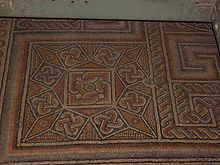 Multiple Solomon's knots in a mosaic in the Church of the Nativity (Israel)
Multiple Solomon's knots in a mosaic in the Church of the Nativity (Israel)
Since the knot has been used across a number of cultures and historical eras, it can be given a range of symbolic interpretations.
Because there is no visible beginning or ending, it may represent immortality and eternity—as does the more complicated Buddhist Endless Knot.
Because the knot seems to be two entwined figures, it is sometimes interpreted as a Lover's Knot, although that name may indicate another knot.
Because of religious connections, the knot is sometimes designated the all-faith symbol of faith, but, at the same time, it appears in many places as a valued secular symbol of prestige, importance, beauty.
Solomon’s Knot appears on tombstones and mausoleums in Jewish graveyards and catacombs in many nations. In this context, Solomon’s Knot is currently interpreted to symbolize eternity.
Some seek to connect it with Solomon by translating the Hebrew word peka'im (פקעים) found in the Bible at I Kings 6:18 and I Kings 7:24 as meaning "knobs" or "knots", and interpreting it to refer to Solomon's knot; however, the more accepted modern translation of this word is "gourd-shaped ornaments".
In Africa, Solomon’s knot is found on glass beadwork, textiles, and carvings of the Yoruba people. When the knot appears in this culture, it often denotes royal status; thus, it is featured on crowns, tunics, and other ceremonial objects. Also in Africa, the Knot is found on Kasai velvet, the raffia woven cloth of the Kuba people. They attribute mystical meaning to it, as do the Akan People of West Africa who stamp it on their sacred Adinkra cloth. In the Adinkra symbol system, a version of Solomon's knot is the Kramo-bone symbol, interpreted as meaning "one being bad makes all appear to be bad".
In Latvia, when Solomon’s knot is used on textiles and metal work, it is associated with time, motion, and the powers of ancient pagan gods.
In modern science, some versions of the conventionalized sign for an atom (electrons orbiting a nucleus) are variations of Solomon’s knot. The logo of the Joomla software program is a Solomon’s knot.
See also
References
Sources
A book-length illustrated study of Solomon’s Knot is Seeing Solomon’s Knot, With Photographs by Joel Lipton by Lois Rose Rose, Los Angeles, 2005 (official website http://www.StoneandScott.com/solomonsknot.asp).
A few archaeological reports, art books, craft manuals, museum catalogs, auction catalogs, travel books, and religious documents which discuss or depict the Solomon’s Knot configuration are listed below:
- Bain, George. Celtic Art: The Methods of Construction. New York: Dover Publications, 1951, 1973, ISBN 0486-22923-8, 9780486229232. (Examples and history of Solomon’s Knot with many elaborations, pp. 27, 59, 71, 87.)
- Bronze Age Civilization of Central Asia, The: Recent Soviet Discoveries. Armonk, New York: M.E. Sharpe, 1981. (Early examples of Solomon’s Knot from the Gonur 1 settlement, figure 4, p. 233.)
- Chen, Lydia. Chinese Knotting. Taiwan: Echo Publishing Company, 1981, ISBN 0-8048-1389-2. (Instructions for creating a “flat” or Solomon’s Knot, p. 58.)
- Christie's Catalog: The Erlenmeyer Collection of Ancient Near Eastern Stamp Seals and Amulets. London: Christie, Manson & Woods, Auction June 6, 1989. (Cruciform interlace carved stone seal, Ubaid, circa 4500 BCE, Lot 185.)
- Fraser, Douglas and Herbert M. Cole, eds. African Art and Leadership. Madison, Milwaukee, and London: University of Wisconsin Press, 1972.
- Cole, Ibo Art and Authority, p. 85.
- Fraser: Symbols of Ashanti Kingship, pp. 143–144.
- Fraser: King’s ceremonial stool, personal choices of various African leaders, p,209, p. 215, p. 283, p. 290, p. 318
- Fraser: More attention should be paid to the significance of the Solomon’s Knot motif, p. 318.
- Laine, Daniel. African Kings. Berkeley, Toronto: Ten Speed Press, 1991, ISBN 1-58008-272-6. (Two Nigerian chiefs, Oba Oyebade Lipede and Alake of Abeokuta, wear garments with embroidered Solomon’s Knots, p. 63.)
- Lusini, Aldo. The Cathedral of Sienna. Sienna, Italy: 1950. (The choir stall, carved 1363 to 1425: photographs of stalls showing variations of Solomon’s Knot, plate 49, pp. 20–21.)
- Wolpert, Stuart. “UCLA Chemists Make Molecular Rings in the Shape of King Solomon’s Knot, a Symbol of Wisdom,” News release from the University of California at Los Angeles, January 10, 2007, http://www.newsroom.ucla.edu/portal/ucla/UCLA-Chemists-Make-Molecular-Rings-7626.aspx?RelNum=7626.
External links
- L4a1 knot-theoretic link on Knot atlas site
Family and reputed relations Occurrences Views Reputed works Related articles Categories:- Solomon
- Knot theory
- Decorative knots
Wikimedia Foundation. 2010.


